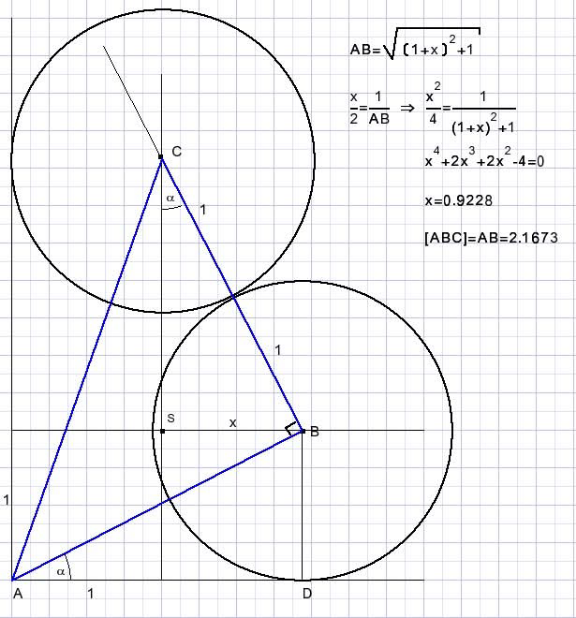
Question Number 214427 by ajfour last updated on 08/Dec/24
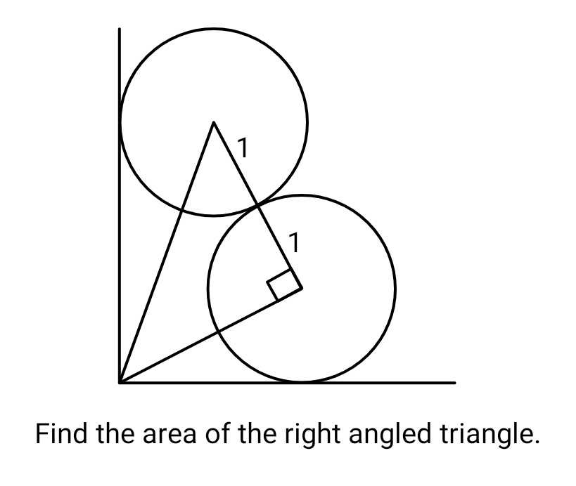
Commented by ajfour last updated on 08/Dec/24
https://youtu.be/pnMSZ77i2P8?si=OaLd0p_DlkwNYv8d
Answered by a.lgnaoui last updated on 08/Dec/24
![Resolution de l equation donne x=0,60048518 alors Aire=x+1=1,60048518 autre Methode Aire= Aire[Care( OAED)]=1 2Aire(OEC)=2×(x/2)=x A=A(Care)+2A(OEC)=x+1](Q214431.png)
$$\mathrm{Resolution}\:\mathrm{de}\:\mathrm{l}\:\mathrm{equation}\:\mathrm{donne} \\ $$$$\boldsymbol{\mathrm{x}}=\mathrm{0},\mathrm{60048518} \\ $$$$\mathrm{alors}\:\:\:\:\boldsymbol{\mathrm{Aire}}=\boldsymbol{\mathrm{x}}+\mathrm{1}=\mathrm{1},\mathrm{60048518} \\ $$$$ \\ $$$$\mathrm{autre}\:\mathrm{Methode} \\ $$$$\:\mathrm{Aire}=\:\mathrm{Aire}\left[\mathrm{Care}\left(\:\mathrm{OAED}\right)\right]=\mathrm{1} \\ $$$$\mathrm{2Aire}\left(\mathrm{OEC}\right)=\mathrm{2}×\frac{\mathrm{x}}{\mathrm{2}}=\mathrm{x} \\ $$$$\mathrm{A}=\mathrm{A}\left(\mathrm{Care}\right)+\mathrm{2A}\left(\mathrm{OEC}\right)=\mathrm{x}+\mathrm{1} \\ $$$$\:\: \\ $$
Commented by a.lgnaoui last updated on 08/Dec/24

Commented by a.lgnaoui last updated on 08/Dec/24
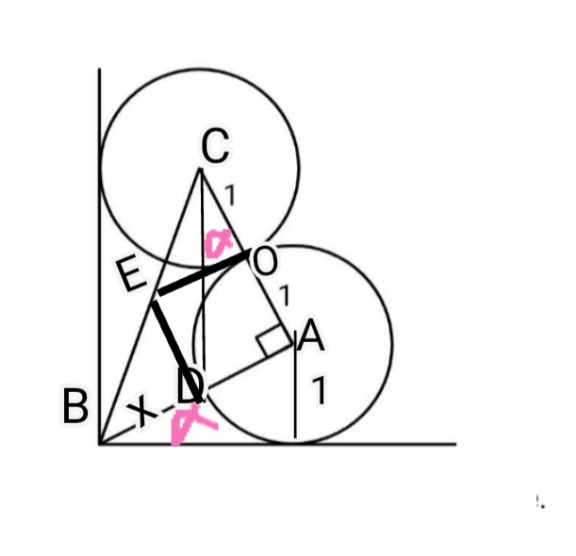
Commented by mr W last updated on 08/Dec/24

$${clearly}\:{wrong}!\:{even}\:{from}\:{the} \\ $$$${diagram}\:{one}\:{can}\:{see}\:{that}\:{your}\:{x} \\ $$$${should}\:{be}\:\approx\:\mathrm{1}\:{and}\:>\mathrm{1}.\:{so}\:{your}\:{answer} \\ $$$$\boldsymbol{\mathrm{x}}=\mathrm{0},\mathrm{60048518}\:{is}\:{wrong}. \\ $$
Answered by mr W last updated on 08/Dec/24
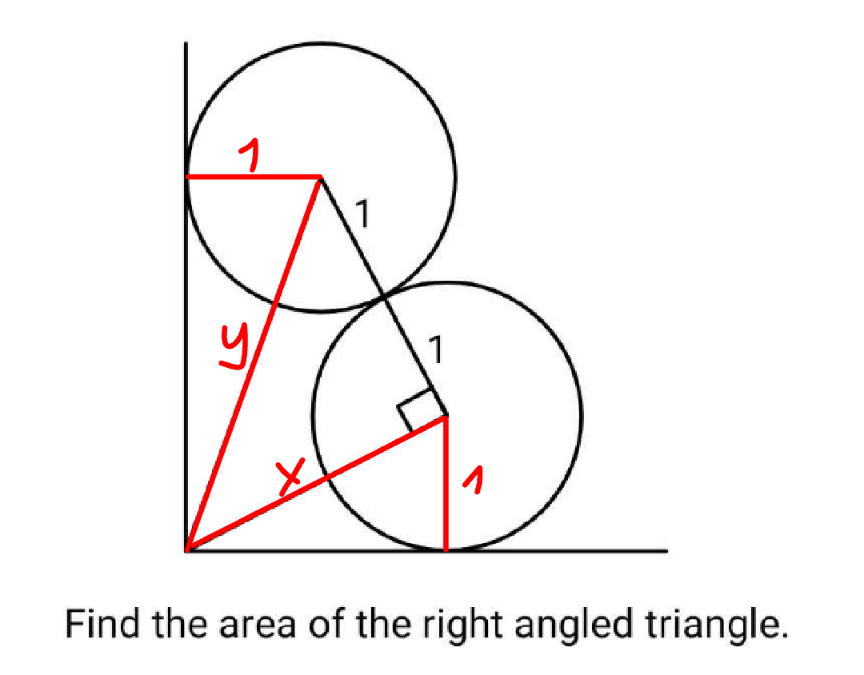
Commented by mr W last updated on 08/Dec/24
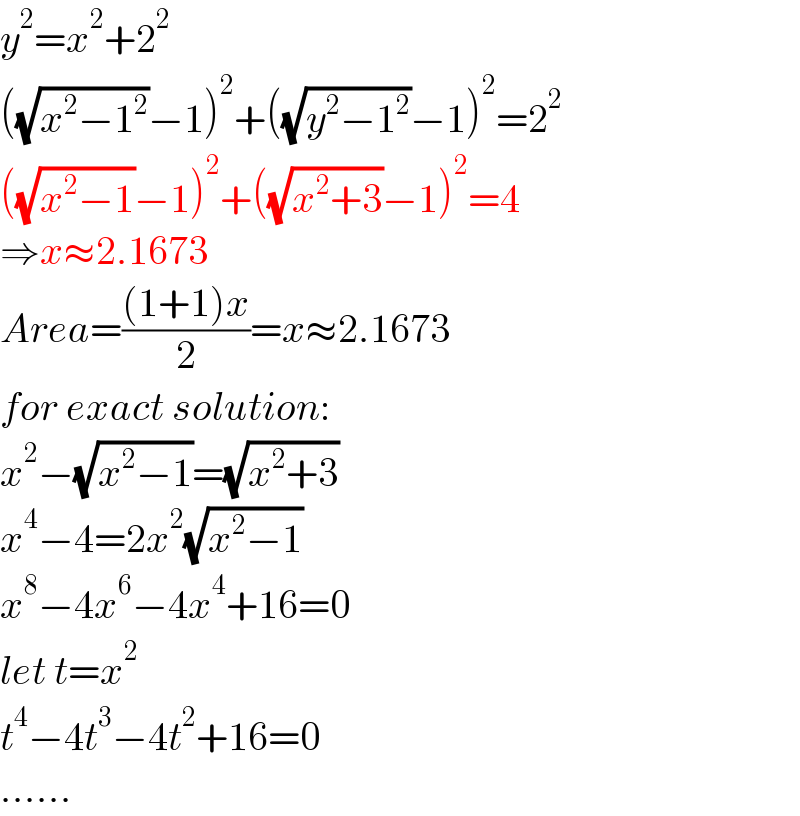
$${y}^{\mathrm{2}} ={x}^{\mathrm{2}} +\mathrm{2}^{\mathrm{2}} \\ $$$$\left(\sqrt{{x}^{\mathrm{2}} −\mathrm{1}^{\mathrm{2}} }−\mathrm{1}\right)^{\mathrm{2}} +\left(\sqrt{{y}^{\mathrm{2}} −\mathrm{1}^{\mathrm{2}} }−\mathrm{1}\right)^{\mathrm{2}} =\mathrm{2}^{\mathrm{2}} \\ $$$$\left(\sqrt{{x}^{\mathrm{2}} −\mathrm{1}}−\mathrm{1}\right)^{\mathrm{2}} +\left(\sqrt{{x}^{\mathrm{2}} +\mathrm{3}}−\mathrm{1}\right)^{\mathrm{2}} =\mathrm{4} \\ $$$$\Rightarrow{x}\approx\mathrm{2}.\mathrm{1673} \\ $$$${Area}=\frac{\left(\mathrm{1}+\mathrm{1}\right){x}}{\mathrm{2}}={x}\approx\mathrm{2}.\mathrm{1673} \\ $$$${for}\:{exact}\:{solution}: \\ $$$${x}^{\mathrm{2}} −\sqrt{{x}^{\mathrm{2}} −\mathrm{1}}=\sqrt{{x}^{\mathrm{2}} +\mathrm{3}} \\ $$$${x}^{\mathrm{4}} −\mathrm{4}=\mathrm{2}{x}^{\mathrm{2}} \sqrt{{x}^{\mathrm{2}} −\mathrm{1}} \\ $$$${x}^{\mathrm{8}} −\mathrm{4}{x}^{\mathrm{6}} −\mathrm{4}{x}^{\mathrm{4}} +\mathrm{16}=\mathrm{0} \\ $$$${let}\:{t}={x}^{\mathrm{2}} \\ $$$${t}^{\mathrm{4}} −\mathrm{4}{t}^{\mathrm{3}} −\mathrm{4}{t}^{\mathrm{2}} +\mathrm{16}=\mathrm{0} \\ $$$$...... \\ $$
Commented by ajfour last updated on 08/Dec/24
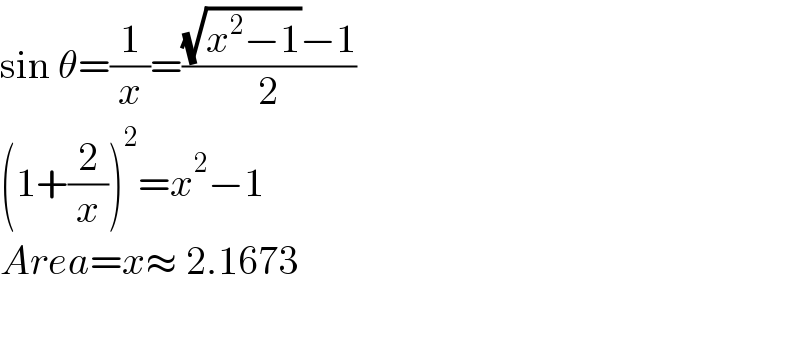
$$\mathrm{sin}\:\theta=\frac{\mathrm{1}}{{x}}=\frac{\sqrt{{x}^{\mathrm{2}} −\mathrm{1}}−\mathrm{1}}{\mathrm{2}} \\ $$$$\left(\mathrm{1}+\frac{\mathrm{2}}{{x}}\right)^{\mathrm{2}} ={x}^{\mathrm{2}} −\mathrm{1} \\ $$$${Area}={x}\approx\:\mathrm{2}.\mathrm{1673}\: \\ $$$$ \\ $$
Answered by Spillover last updated on 11/Dec/24
